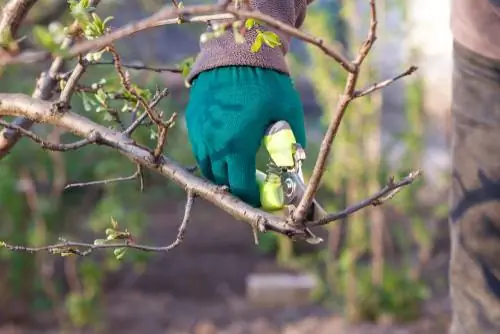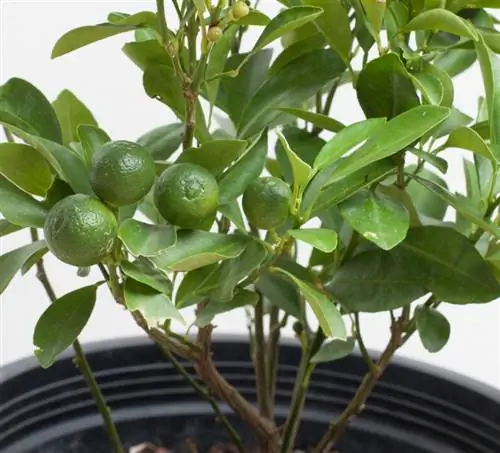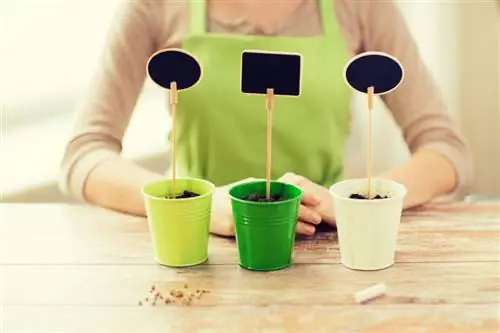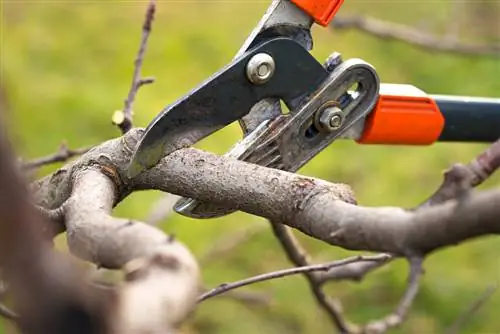- Author admin [email protected].
- Public 2023-12-16 16:46.
- Last modified 2025-01-23 11:21.
Behind its eerie name, the blood plum has dark red foliage and picturesque spring flowers, followed by juicy, sweet fruits in autumn. The magnificent flower and fruit tree thrives as a majestic shrub that takes on a tree-like habit as it ages. With a topiary cut, the refined version of the cherry plum maintains a compact, densely leafy shape. You can read about when and how to properly cut a blood plum in this tutorial.

How do I cut a blood plum properly?
To properly prune a blood plum, you should carry out training pruning after the flowering period for shaping, use topiary pruning at the end of June if necessary and thinning pruning every 3 to 5 years in February to promote he althy growth.
When and how to cut?
Naturally, the blood plum thrives as a large, tree-like shrub with a stable framework. The pink-white to reddish cup flowers appear onannual side shoots In late summer and autumn of the previous year, a blood plum lays the buds for the fresh spring blossom show. As they get older, the flower shoots droop, which is not always to the gardener's taste. For small gardens, we recommend training with a limited number of scaffolding shoots. Thinning out dead wood prevents premature balding. The following table summarizes all sensible types of cuts with recommended dates:
| Cut style | Goal/Occasion | best date |
|---|---|---|
| Educational Cut | build a compact shrub shape | after the flowering period to the final height |
| Topiary | shorten overhanging shoots | if necessary after the flowering period at the end of June (St. John's Day) |
| Blending cut | Remove dead wood, promote light-flooded growth | every 3 to 5 years in February to early March |
Aradical rejuvenation cutleads to blood plumsnot successful Although the tree has sleeping eyes, it lacks the vigor to grow after one Drive out the rejuvenation cut vigorously. Instead of putting a neglected shrub on the stock, a combination of shape and thinning pruning is conceivable, which ideally takes place in late winter.
Instructions for parenting pattern
If a blood plum can develop freely in its location, there is no need for training pruning. In a small garden, there are many advantages to growing flowering plants with a limited number of ground shoots. The available space can be used optimally. In addition, there will be no space problems in later years that would require radical pruning or even clearing. How to properly train a blood plum:
- The best time is after the flowering period at the end of June until the desired final height is reached
- Train blood plum with 3 to 5 strong ground shoots as a permanent framework
- Cut off excess ground shoots to 10 cm short cones
- Extend scaffolding shoots by about 10 cm every year
By growing selected ground shoots in stages of 10 centimeters per year, you promote stability and load-bearing capacity. It is undoubtedly difficult to prune the desired growth after flowering. As a result of the reduced growth, the blood plum branches better and bears more flowers and fruit.
Tip
The more frequently and vigorously you cut a blood plum, the more the wild rootstock will push through. Keep an eye out for bold wild shoots from the rootstock all year round. Rip out a water shoot as soon as you spot it. Otherwise, the wildlings will overgrow the noble blood plum in no time.
Cutting the blood plum bush - topiary instructions
If your blood plum has successfully completed training, the pruning shears can rest for a few years. Only when ground shoots form branched heads or hang over noticeably does a topiary restore the representative appearance. How to cut correctly:
- The best time is after the flowering period at the end of June, close to St. John's Day (June 24th)
- Please be careful: only cut if there are no bird nests in the wood
- Aging, overhanging shoots can be slimmed down using a derivation cut
- To do this, select a lower, outward-facing side shoot
- Cut 0.5 to 1 cm into the old wood at the junction of both shoots to remove the aged part of the shoot
A topiary doesn't come into the schedule every year. The already slow growth of around 25 centimeters per year in the youth phase is reduced to a leisurely 5 to 10 centimeters on older plums. It takes several years before overhanging branches form again after professional topiary.

An older blood plum bush is falling apart with heavily overhanging shoots. Topiary pruning after flowering solves the aesthetic problem. With the help of the derivation cut, you can direct hanging and heavily branched shoots to a deeper side shoot.
Excursus
Hattering business has top priority
Blood plums are a popular summer haunt for our feathered friends. The richly flowering and fruiting wood offers birds ideal conditions for raising their offspring. The cutting time of the blood plum and the breeding business collide. According to the Federal Nature Conservation Act, there is no doubt about whose needs take priority. Paragraph 39 states that from March 1st to September 30th all types of pruning are strictly prohibited. Light maintenance cuts may be carried out as long as it can be safely ruled out that nesting birds will be disturbed or even frightened away.
Thinning cut prevents premature baldness
Regular thinning pruning is an effective way to prevent a blood plum from settling prematurely on the old floral part. Every 3 to 5 years, old, dead wood is removed to pave the way for young shoots to come to light. The aim of the pruning measure is to create an airy yet stable shrub that is bathed in sunshine deep into the center so that it can carry out photosynthesis diligently. How to make the right thinning cut:
- The best time is every 3 to 5 years in February when the weather is frost-free
- Inspect the bush carefully in advance for hibernating animals so as not to cut if necessary
- Cut off dead, stunted and frozen shoots
- Thin branches on cones (see explanations below)
When leafless, the blood plum gives you an unhindered view of the network of branches. You can easily seeswelling flower budsin order todon't cut in these places Dead wood should only be thinned out if there is no option to identify one young, vital side shoot. A vitality test dispels any remaining doubts. Scrape off some of the bark. If light, juicy tissue emerges, it is a living shoot that should not be cut. Brown, dry tissue reveals dead wood without any ifs and buts.
Background
Cut thick shoots onto cones
Like all plums, the blood plum is prone to wood rot on large cuts. If you find yourself forced to remove an old, thick branch, pleasedon't cut it on a string There is a risk that the wound will dry out very deeply and pave the way for wood-destroying fungal spores. You can effectively prevent wood rot if you cut the branch in question back to a 10 centimeter long cone. Use this cutting technique if the diameter of the cut is larger than half the diameter of the remaining main shoot or trunk. Over the next 2 to 3 years, the main shoot becomes thicker and young branches sprout from the cone. At this stage, remove the now dried remains of the cones in the summer so that the blood plum can quickly close the wound.
Frequently asked questions
We have gradually reduced our 20-year-old blood plum bush from 7 meters high to 3 meters over the past few years. For some time now the shrub has only had green leaves instead of the original dark red leaves. There is no sign of flowers anywhere. What did we do wrong?
If a blood plum only has green foliage, the wild rootstock has pushed through. A strong pruning always encourages the simple Prunus cerasifera to sprout as a rootstock. If the wild shoots are not removed promptly, they will soon displace the red-leaved graft. However, the rootstock should also bloom and fruit. However, if pruning takes place in autumn or late winter, the buds that have already formed fall victim to it. Always prune the blood plum after flowering and remove the wild shoots immediately.
My blood plum is currently starting its third year. Can I still transplant the shrub in March? What should you pay attention to?
Spring is a good time to change location. Within the first five years of growth, the blood plum tolerates the stressful procedure without any problem. You can make growth easier by cutting back all shoots by about a third. Water abundantly and regularly. To ensure constant soil moisture, it is advisable to mulch the root disc. If you place your blood plum in a mix of fresh potting soil and compost, the rooting in the new location will progress quickly.
How is it that the blood plum is limited to a height of 300 to 400 centimeters as a shrub and at least 8 meters high as a tree?
The stronger and bushier a tree branches, the lower the forces for height growth. The sap flow is distributed over significantly more buds and shoots than in the crown of a tree. Under ideal location conditions and with a lot of patience, the blood plum as a shrub will give you a maximum height of 5 to 6 meters, but only at an advanced age.
The 3 most common cutting mistakes
A blood plum without flowers or fruit or with boring, green leaves is the result of classic pruning mishaps. So that you don't have to deal with such deficiencies, the following table documents the most common cutting errors and provides helpful tips for preventative measures.
| Cutting errors | malicious image | Prevention |
|---|---|---|
| cut in autumn or late winter | Loss of flowering and fruiting | prune after flowering |
| Wild shoots not removed | green leaves because the rootstock sprouts | Tear off wild shoots promptly |
| never photographed | bare crown, few flowers and fruits | thinning every 3 to 5 years in February |
Tip
A blood plum with full flowers is not allowed in the natural garden. Picturesque varieties with simple flowers, such as the magical 'Nigra', are swarmed by bees, bumblebees and butterflies. Here the table is richly laid with nectar and pollen. Varieties with double flowers are a disappointing deception for busy insects, as there is no trace of nectar anywhere.






